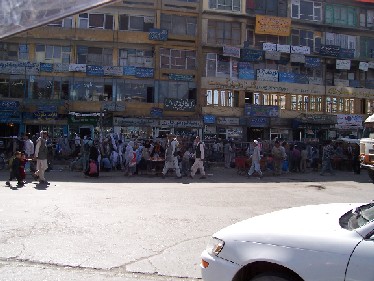On
the
Scene
II:
Afghanistan's
Neighbors
Look
With
Interest
at
Licensing
Proposal
9/30/05
While the Western powers like Britain and the United States are making the most noise about Afghan opium production and throwing the most money into efforts to thwart it, experts at this week's Kabul symposium on the feasibility of licensing Afghan production for the global legitimate medicinal market said most Afghan opium and heroin is destined not for the West, but for the developing world, with neighboring Iran and Pakistan responsible for much of the market. That may come as a surprise to readers in the West, but it is old news to the countries most affected, some of whom sent representatives to the meeting to see whether the proposal could fly.
While Afghan heroin is making its way into the veins of junkies across Western Europe, most accounts suggest little of it gets to North America, where most heroin comes from Colombia and Mexico. Russia and Iran, however, both lay astride major trafficking routes from Afghanistan to the West. In addition to problems related to the drug trade, both countries are seeing rising addiction rates because of the flood of cheap Afghan heroin, the officials said. "People tend to think most heroin goes to the US and Europe, but the US and Europe combined consume only about 80 tons a year out of the estimated 400-plus tons produced annually," said Pierre Kopp, professor of economics at Paris 1 University in France. "The biggest heroin consuming countries are now the developing countries, which account for about two-thirds of global consumption, especially places like Iran and Pakistan. There are 1.5 million heroin users in Pakistan now," Kopp reported. There are two distinct business models and price structures for the heroin industry, one aimed at the prosperous West and one targeting developing countries, said Kopp. "In the developing countries, you have many consumers and the price is very low, so you make your profit on the huge number of consumers. The gram of heroin that goes for $2 in Pakistan goes for $100 in the US, and the retail heroin market in the US is worth about $7 billion, but even at $2 a gram in Pakistan, there is a total retail market of $1.2 billion there," he said. While the profits of the Afghan drug trade are huge, most of them take place at the retail level, said Kopp. "If you ask where the money is made, you see that the farmers don't make a lot of profit. Afghan growers made about $400 million, while the traffickers took in about $2.2 billion, with the rest accruing to operations retailing the drugs." With Afghan heroin going for $5 a gram in neighboring Iran, it is becoming an increasingly attractive option for impoverished people seeking a little bliss. As a result, the UN Office on Drugs and Crime estimates that Iran now has roughly two million opiate addicts, although that number could be as high as four million according to some Iranian government estimates. Thus the presence of the Iranian Embassy in Kabul Drugs Liaison Officer Hashem Zayyem at the Senlis symposium this week. "This is a big, big problem for us," he told DRCNet. "Addiction rates are rising, and more of more of the young people are using heroin, not opium." Iranian authorities, who after the installation of the Islamic Republic in 1979 adopted a hard-line approach to illicit drug use, even publicly executing small-time drug dealers, are changing their approach in the face of a tide of opiate use. In a symposium presentation on the effectiveness of various treatment modalities and harm reduction measures, Professor Ambros Uchtenhagen, chair of the Swiss Addiction and Public Health Research Foundation, lauded Canada's embrace of the "four pillars" approach -- prevention, treatment, harm reduction, and law enforcement -- and said that, faced with the rise of opiate addiction, Iran had recently begun to embrace the same policies. "In Iran, they have begun to adopt the same policy with the same objectives, and now we are seeing the first results," said Uchtenhagen. "I am deeply impressed with what is going on in Iran, with the rapid development of substitution programs for opiate dependent people and outreach programs in Teheran where former addicts distribute needles and tell users about drop-in clinics. There is also low-threshold anonymous treatment." While in Iran, authorities are tackling demand, the Iranian Embassy's Zayyem works the supply side. "Our border with Afghanistan is long, and the smugglers are dangerous," he said. "We have had more than 3,500 border police killed fighting traffickers since the beginning of the Islamic Republic, he said. "And that's not counting soldiers and police." Despite rising tensions between Iran and the West over the country's nuclear program, Zayyem said his country is working with the West to combat trafficking across the Afghan border. "This is one area where we have good cooperation with the United States and the United Kingdom," he said with a rueful smile. "But we need more help," he shrugged. "This proposal for licensing the opium crop is very interesting," he said. "I will be reporting on this to the ambassador."
"We have a very severe problem with heroin and other opiates in Russia," said Timur Agemetov, second secretary at the Russian Embassy in Kabul, who attended the symposium. "I will be reporting back to my ambassador on this intriguing proposal," he told DRCNet. "I don't know if it is possible, but anything that would reduce the amount of heroin coming into Russia would be most helpful," he said. Like Iran, Russia faces not only rising domestic use rates but also the consequences of black market drug trafficking, said Agemetov. "We have troops in Tajikistan to help stem the flow of narcotics," he said, "but it keeps coming -- not only through Tajikistan but all across Central Asia -- and the drug mafias are very strong." If the reactions of Iranian and Russian representatives at the symposium are any indication, the Senlis Council's opium licensing proposal is going to be getting a careful hearing not only in Kabul, but in the region as well. If regional governments officially weigh in in support of the notion, that could only add to pressure for innovative solutions to the Afghan opium conundrum.
|


